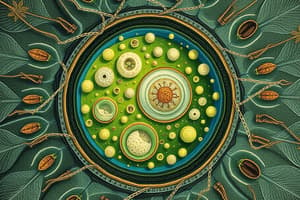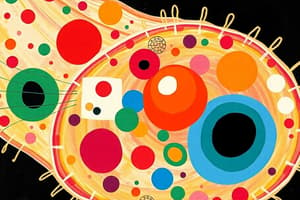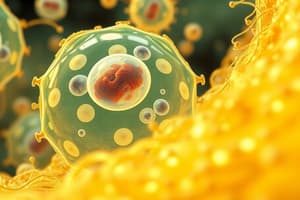Podcast
Questions and Answers
Which of the following statements accurately describes the function of the Golgi body?
Which of the following statements accurately describes the function of the Golgi body?
- Generating energy for the cell through glucose metabolism.
- Sorting and packaging proteins and molecules for transport out of the cell. (correct)
- Storing water and nutrients and providing structural support to the cell.
- Synthesizing proteins that are essential for the cell's structure.
All cells, regardless of their origin, spontaneously arise from non-cellular material.
All cells, regardless of their origin, spontaneously arise from non-cellular material.
False (B)
What is the main function of the cell membrane?
What is the main function of the cell membrane?
to control the flow of materials in and out of the cell
The organelle responsible for carrying out photosynthesis in plant cells is the ______.
The organelle responsible for carrying out photosynthesis in plant cells is the ______.
Match the following organelles with their primary functions:
Match the following organelles with their primary functions:
Which of the following structures is found in plant cells but not typically in animal cells?
Which of the following structures is found in plant cells but not typically in animal cells?
Eukaryotic cells all possess a cell wall for structural support.
Eukaryotic cells all possess a cell wall for structural support.
What role does the cytoskeleton play in the cell?
What role does the cytoskeleton play in the cell?
The network of membrane-covered channels that deliver nutrients made in the cell is called the ______.
The network of membrane-covered channels that deliver nutrients made in the cell is called the ______.
Lysosomes are responsible for:
Lysosomes are responsible for:
Flashcards
Cell Theory
Cell Theory
All living things are composed of cells.
Organelles
Organelles
Specialized structures within a cell with specific functions.
Cell Membrane
Cell Membrane
The outer boundary of a cell that controls what enters and exits.
Cytoplasm
Cytoplasm
Signup and view all the flashcards
Mitochondria
Mitochondria
Signup and view all the flashcards
Ribosomes
Ribosomes
Signup and view all the flashcards
Endoplasmic Reticulum (ER)
Endoplasmic Reticulum (ER)
Signup and view all the flashcards
Golgi Body
Golgi Body
Signup and view all the flashcards
Nucleus
Nucleus
Signup and view all the flashcards
Cell Wall
Cell Wall
Signup and view all the flashcards
Study Notes
- In 1665, Robert Hooke was the first to study cells.
- All organisms consist of one or more cells.
- The cell is the fundamental unit of life.
- All cells originate from pre-existing cells.
Cell Structure
- Eukaryotic cells contain unique parts called organelles.
- Organelles perform specialized functions vital for life.
- Plant and animal cells have some differences in their organelles.
- Organelles manage energy, store proteins and carbohydrates, eliminate waste, transport substances, acquire nutrients, and reproduce.
Organelles
- The cell membrane separates the cell's interior from its external environment.
- The cell membrane regulates the movement of materials in and out of the cell.
- Cytoplasm is a jelly-like substance that supports organelles and contains vital materials.
- Mitochondria provide fuel for the cell by releasing energy from glucose.
- Ribosomes produce proteins and are found floating in the cytoplasm or attached to the endoplasmic reticulum.
- The Endoplasmic Reticulum (ER) is a network of membrane-covered channels that deliver nutrients within the cell.
- Vesicles store or deliver nutrients across the cell membrane.
- The Golgi Body sorts and packages proteins and molecules for transport out of the cell.
- The nucleus controls all cell activities and is enclosed by the nuclear membrane; its center is called the nucleolus.
- Vacuoles store water and nutrients and facilitate storage or transportation within the cell.
- The cytoskeleton consists of filaments and tubules that provide a framework for the cell.
- Lysosomes contain enzymes that digest nutrients.
- The cell wall is a tough structure outside the plant cell membrane protecting it from bursting.
- Chloroplasts trap solar energy to produce glucose through photosynthesis.
Animal Cells
- Typically round in shape.
- Do not have a cell wall.
- Do not contain chloroplasts.
- Contain lysosomes.
- Have many small vacuoles.
Plant Cells
- Typically square in shape.
- Have a cell wall.
- Contain chloroplasts.
- Do not contain lysosomes.
- Have one large vacuole.
Studying That Suits You
Use AI to generate personalized quizzes and flashcards to suit your learning preferences.




